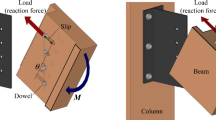Abstract
A Dou-gong joint is one of the essential components in traditional Chinese timber structures. This work investigates the seismic performance of Dou-gong joints under cyclic loading through experiments and model calibration. Four full-scale joints were subjected to cyclic loading to study the failure mechanism and ability to dissipate energy. The test results indicated that a Dou-gong joint will finally fail with a large overall tilt. The Dou-gong joint itself had a strong ability to dissipate energy through shear deformation and the extrusion of different components. The maximum load-bearing capacity in the Y direction was larger than that in the X direction because the Dou and Xiao components perform better in the Y direction than in the X direction. A macro model whose nonlinearity was governed by a spring element was used to model a Dou-gong joint. The spring element was separately assigned to two different hysteretic models, and the model parameters were calibrated using the tested data. Both the advantages and disadvantages of the two hysteretic models are compared and discussed. The obtained seismic performance of a Dou-gong joint provides useful and valuable information to maintain and retrofit historic Chinese timber structures.















Similar content being viewed by others
References
ASTM E2126–19 (2011) Standard test methods for cyclic (reversed) load test for shear resistance of vertical elements of the lateral force resisting systems for buildings. Am Soc Test Mat Stand
Bilinear model (2006) http://opensees.berkeley.edu/wiki/index.php/Hysteretic_Material
Branco JM, Piazza M, Cruz PJS (2011) Experimental evaluation of different strengthening techniques of traditional timber connections. Eng Struct 33(8):2259–2270
Cao J, Xiong H, Chen J, Huynh A (2019) Bayesian parameter identification for empirical model of CLT connections. Constr Build Mater 218:254–269
Cao J, Xiong H, Wang Z, Chen J (2020a) Experimental investigation and numerical analysis for concrete-CLT connections. Constr Build Mater 236:117533
Cao J, Xiong H, Zhang FL, Chen L, Cazador C (2020b) Bayesian model selection for the nonlinear hysteretic model of CLT connections. Eng Struct 223:111118
Cao J, Zhao Y, Liu Y, Lv H, Wang W (2021) Load-carrying capacity analysis of traditional Chinese Dou-gong joints under monotonic vertical and reversal lateral loading. J Build Eng 102847
Chen ZY, Lu WZ, Zhu EC, Pan JL (2012) Structural performance of dougong brackets of yingxian wood pagoda under vertical load—refined finite element modelling. Sci Technol Eng 12(4):95–100
Chen Z, Zhu E, Lam F, Pan J (2014) (2014) Structural performance of Dou-Gong brackets of Yingxian Wood Pagoda under vertical load–An experimental study. Eng Struct 80:274–288
Chen C, Qiu H, Lu Y (2016) Flexural behaviour of timber dovetail mortise–tenon joints. Constr Build Mater 112:366–377
Chen J, Li T, Yang Q, Shi X, Zhao Y (2018) Degradation laws of hysteretic behaviour for historical timber buildings based on pseudo-static tests. Eng Struct 156:480–489
Chun Q, Meng Z, Han Y (2017) Research on mechanical properties of main joints of Chinese traditional timber buildings with the type of post-and-lintel construction. Int J Archit Herit 11(2):247–260
Exponent PU. Saws model (Opensees user documentation); 2010. < http:// opensees.berkeley.edu/wiki/ index.php/SAWS_Material > . (SAWS model)
Foschi RO (1977) Load-slip characteristics for connections with common nails. Wood Sci 9:118–123
JGJ/T 101–2015: Specification for seismic test of buildings. Beijing, China: China Building Industry Press; 2015
Kang M, Yang N, Cha Q (2011) Studies on static performance of mortise and tenon joint in traditional column and tie construction timber structure//2011 International Conference on Electric Technology and Civil Engineering (ICETCE). IEEE, 6197–6200
Li X, Zhao J, Ma G, Chen W (2015) Experimental study on the seismic performance of a double-span traditional timber frame. Eng Struct 98:141–150
Lukic R, Poletti E, Rodrigues H, Vasconcelos G (2018) Numerical modelling of the cyclic behavior of timber-framed structures. Eng Struct 165:210–221
McKenna F (2011) OpenSees: a framework for earthquake engineering simulation. Comput Sci Eng 13:58–66
Mitra N. Pinching4 model (Opensees user documetation); 2012. <http://opensees.berkeley.edu/ wiki/index.php/Pinching4_Material>
Parisi MA, Piazza M (2002) Seismic behavior and retrofitting of joints in traditional timber roof structures. Soil Dyn Earthq Eng 22(9–12):1183–1191
Suzuki Y, Maeno M (2006) Structural mechanism of traditional wooden frames by dynamic and static tests. Struct Control Health Monit 13(1):508–522
Tanahashi H, Suzuki Y (2020) Review on the mechanical models and formulations of embedment of traditional timber joints in Japan. Jpn Archit Rev 3(2):148–164
Wu Y, Song X, Gu X, Luo L (2018a) Dynamic performance of a multi-story traditional timber pagoda. Eng Struct 159:277–285
Wu Y, Song X, Li K (2018b) Compressive and racking performance of eccentrically aligned dou-gong connections. Eng Struct 175:743–752
Xie Q, Wang L, Zhang L, Zhang T (2019a) Seismic behaviour of a traditional timber structure: shaking table tests, energy dissipation mechanism and damage assessment model. Bull Earthq Eng 17(3):1689–1714
Xie Q, Zhang L, Wang L, Zhou W, Zhou T (2019b) Lateral performance of traditional Chinese timber frames: EXPERIMENTS and analytical model. Eng Struct 186:446–455
Acknowledgements
This paper is funded by the Open Program of Henan Key Laboratory of Grain and Oil Storage Facility & Safety (No. 2021KF-B01). The first author would like to acknowledge the support from the 2022 Open Project of State Key Laboratory of Hydraulic Engineering Simulation and Safety, Tianjin University (No. HESS-2218). The financial support is greatly appreciated. The authors also thank the anonymous reviewers for their constructive comments.
Author information
Authors and Affiliations
Corresponding author
Ethics declarations
Conflict of interest
The authors declare that they have no known competing financial interests or personal relationships that could have appeared to influence the work reported in this paper.
Additional information
Publisher's Note
Springer Nature remains neutral with regard to jurisdictional claims in published maps and institutional affiliations.
Supplementary Information
Below is the link to the electronic supplementary material.
Rights and permissions
About this article
Cite this article
Cao, J., Li, X., Liu, Y. et al. Seismic performance investigation of the Dou-gong joints of traditional Chinese timber structures. Eur. J. Wood Prod. 81, 173–186 (2023). https://doi.org/10.1007/s00107-022-01863-x
Received:
Accepted:
Published:
Issue Date:
DOI: https://doi.org/10.1007/s00107-022-01863-x




